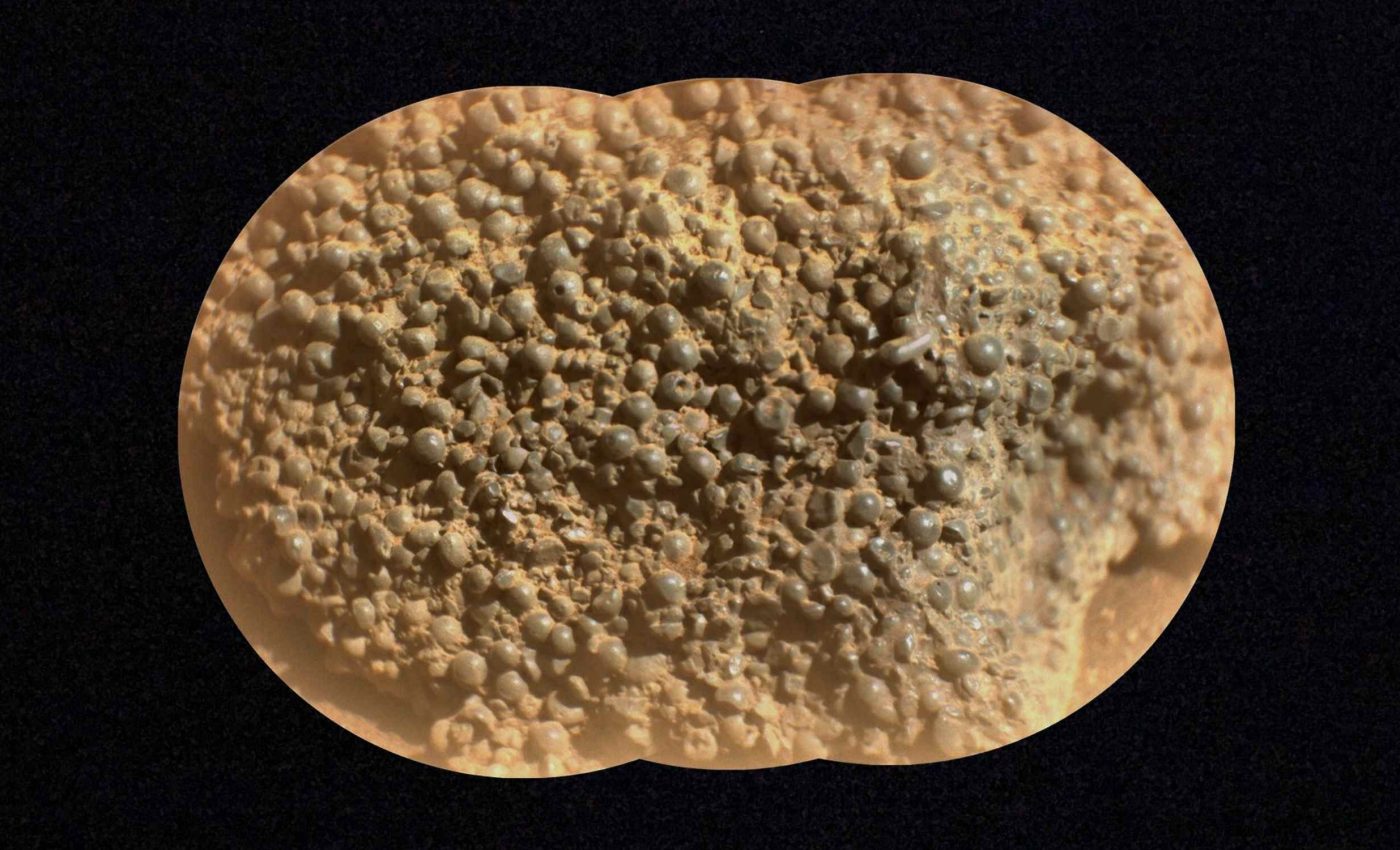
Martian rock looks like a nest of spider eggs
Last week, NASA’s Perseverance rover revealed something unusual on the slopes of Jezero Crater. It snapped a photo of a strange rock, covered in round lumps that looked like spider eggs in a nest.
Dr. Katie Stack Morgan at NASA’s Jet Propulsion Laboratory is leading efforts to figure out how this puzzling object formed and ended up in this location.
Because the rock, now known as St. Pauls Bay, doesn’t seem to match its surroundings, the team suspects it might have been moved by geological processes that took place long ago.
Egg-like spherules in the Mars rock
The rover captured the image on March 11, 2025, showing a large chunk of “float rock” that stands out against the lighter rocks and red dust.
Scientists use the term float rock to describe stones that are no longer in the spot where they formed.
This piece of debris is peppered with spherules less than an eighth of an inch (3 millimeters) in size.
NASA researchers think these spheres could be related to past meteor strikes or are possibly the result of groundwater reactions within the Martian crust.
In 2004, NASA’s Opportunity rover discovered tiny orbs that researchers nicknamed “blueberries.” These spherules were found on Meridiani Planum and were later identified as hematite-rich lumps.
That discovery led to the suggestion that water once flowed through the rock, creating concretions in the process.
But Martian spherules don’t always come from water activity, and other scenarios – like cooling volcanic droplets – can generate similar shapes.
Mars rock spherules and meteors
One possibility is that these mini-spheres formed when a meteorite slammed into the surface and hurled molten bits high into the atmosphere. Those fragments could have cooled rapidly, creating little blobs of rock that fused together.
If that’s the case, this St. Pauls Bay rock might have traveled a considerable distance before landing in its current spot. This movement would offer fresh insights into how impacts scatter materials around the planet.
Another scenario involves groundwater percolating through subsurface rock layers. Over time, mineral-laden water might have cemented certain components, leaving behind small knobs or nodules.
These lumps may have become visible through erosion. If this turns out to be the right track, it would add to evidence that Jezero Crater once hosted liquid water, which intrigues those scientists who are searching for evidence of ancient life.
Placing the rock in context
“The team is now working to link the spherule-rich texture observed in St. Pauls Bay to the wider stratigraphy at Witch Hazel Hill,” NASA officials wrote in a recent update.
They aim to pinpoint which rock layers on the hill match the composition of this peculiar find, and establish whether it simply rolled down the hill.

Geologic mapping with Perseverance’s cameras and instruments will help narrow down where the rock originated.
If they discover a layer that matches St. Pauls Bay, it will fill in gaps about past processes that shaped this corner of Mars.
Why does any of this matter?
Special tools on Perseverance can test the chemistry of the spherules found in the Mars rock. Pinpointing the iron, magnesium, and other elements inside the spheres will guide scientists toward one hypothesis over another.
If the chemical signature leans toward volcanic elements, that may confirm an eruption or impact-related event. On the other hand, a heavy presence of water-altered minerals might hint at a more sedate origin involving groundwater flows.
By pursuing the origin of these lumps, researchers could unravel more about how rocks traveled across the planet. Even a single misplaced stone can hold clues about large-scale collisions, floods, or volcanic outbursts that shaped Mars eons ago.
Rover teams see every oddity as a chance to learn about unseen processes beneath the Red Planet’s surface. More roving observations and sample analyses will determine whether St. Pauls Bay rock is a special case or part of a broader pattern scattered around Jezero Crater.
Solving the Mars rock spherules puzzle
Scientists may soon direct the rover to examine darker layers around the crater that are visible from orbit. If these layers share similar chemistry, it would mean the rock simply rolled downhill.
If not, that outcome could point to an origin far from Witch Hazel Hill. Sorting that out may reveal how widespread spherule formation is within Jezero Crater and whether it links to events elsewhere on Mars.
This puzzling chunk of stone is a tantalizing reminder that we still have much to learn. Even after decades of Mars missions, new discoveries continue to disrupt assumptions.
Although the lumps look like “spider eggs,” there’s no indication of any real alien critters. The small nodules remain a geological phenomenon, and it’s up to researchers to decode their past.
The value of continued investigation
Some experts say even small clues can reshape our understanding of Martian history. One odd rock might rewrite timelines of when volcanic or impact events took place.
Perseverance is designed to collect these intriguing snapshots of planetary evolution. Studying them up close helps build a clearer picture of Mars, layer by layer.
Finding the story in the rocks
The rover’s mission isn’t just about dramatic rocks. It’s about piecing together the puzzle of a once-dynamic world that may have held conditions suitable for microbial life.
Every time NASA encounters an unexpected object like the St. Pauls Bay rock, it highlights the diversity of geological processes that occurred on Mars. By tracking this single rock to its source, researchers can expand our knowledge of planetary processes beyond Earth.
Information for this article comes from a NASA online press release.
—–
Like what you read? Subscribe to our newsletter for engaging articles, exclusive content, and the latest updates.
Check us out on EarthSnap, a free app brought to you by Eric Ralls and Earth.com.
—–













